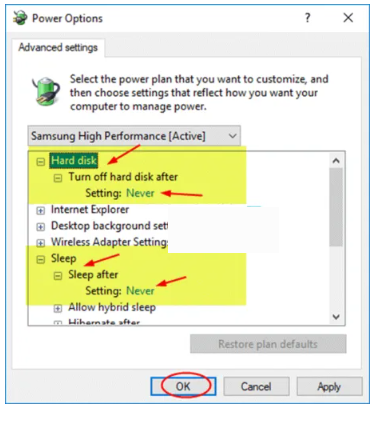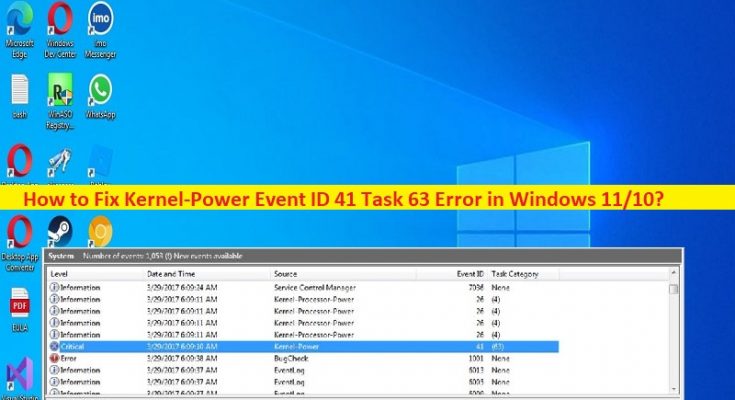What is ‘Kernel-Power Event ID 41 Task 63 Error’ problem in Windows 10/11?
In this article, we are going to discuss on How to fix Kernel-Power Event ID 41 Task 63 Error in Windows 11/10. You are provided with easy steps/methods to resolve the issue. Let’s starts the discussion.
‘Kernel-Power Event ID 41 Task 63’ error:
It is common Windows problem considered as Windows Event Viewer error. When you open Event Viewer app in Windows 10/11 computer in order to check why you are experiencing black or white system screen issue with scratching noise in the background without any alarm, you may experience ‘Kernel-Power Event ID 41 Task 63’ error in Event Viewer app. This error is appeared with Event ID 41 usually when you experience forcedly compute restart/boot issue in the middle of your work on computer. Let’s take a look at error message.
“The system has rebooted without cleanly shutting down first. This error could be caused if the system stopped responding, crashed, or lost power unexpectedly.”
This error indicates you are unable to work on your Windows computer properly and facing automatic restart/boot of your computer while working. There could be several reasons behind the issue including outdated/corrupted device drivers, incorrect or bad configured sleep and hard disk power settings, issue with hardware attached into computer, outdated BIOS, and other issues. One possible way to fix the issue is to update BIOS firmware software to latest version, but there is also some other possible solutions to fix the issue as mentioned in the post. Let’s go for the solution.
How to fix Kernel-Power Event ID 41 Task 63 Error in Windows 11/10?
Method 1: Fix Kernel-Power Event ID 41 Task 63 Error with ‘PC Repair Tool’
‘PC Repair Tool’ is easy & quick way to find and fix BSOD errors, EXE errors, DLL errors, problems with programs/applications, malware or viruses infections in computer, system files or registry issues, and other system issues with just few clicks.
Method 2: Run SFC scan and CHKDSK scan
You can run SFC scan and CHKDSK scan in computer to repair corruption in system files and hard disk drives, in order to fix the issue.
Step 1: Type ‘cmd’ in Windows Search Box and press ‘CTRL + SHIFT + ENTER’ keys on keyboard to open ‘Command Prompt as Administrator’
Step 2: Type the following commands and hit ‘Enter’ key after each to execute.
sfc /scannow
chkdsk C:
Step 3: Once executed, restart your computer and check if the issue is resolved.
Method 3: Run Power troubleshooter

Windows built-in Power troubleshooter can resolve the issue.
Step 1: Open ‘Settings’ app in Windows PC via Windows Search Box and go to ‘System > Troubleshoot > Other troubleshooters’
Step 2: Find and select ‘Power’ troubleshooter, and click ‘Run’ to run the troubleshooter, and follow on-screen instructions to finish troubleshooting. Once finished, check if the issue is resolved.
Method 4: Update device drivers
Updating all necessary device drivers to latest & compatible version can resolve the issue. You can also try to update all Windows drivers including graphics card driver, sound card driver, and other device drivers to latest & compatible version using Automatic Driver Update Tool. You can get this tool through button/link below.
Method 5: Change Sleep and Hard disk power settings

Another way to fix the issue is to change sleep and hard disk power settings in computer.
Step 1: Open ‘Control Panel’ app in Windows PC via Windows Search Box and go to ‘Power & Sleep Settings’ and go to ‘Additional power settings’
Step 2: Click ‘Change plan settings’ for your activate power plan and click ‘Change advanced power settings’ on ‘Edit plan settings’ applet
Step 3: In the opened window, scroll to Hard Disk section and click to expand it. Click ‘Turn OFF hard disk after’ and set it to ‘Never’
Step 4: Now, select ‘Sleep after’ and select to set it to ‘Never’, and then click ‘Apply > Ok’ button to save the changes. Once done, check if the issue is resolved.
Method 6: Use OCCT to test for PSU issues
You can use OCCT (OverClock Checking Tool) to test for PSU issues in order to test your CPU, GPU and motherboard.
Step 1: Save and close all running programs in computer and open ‘OCCT’
Step 2: Under ‘Test Configuration’, select ‘Power’, set ‘Instruction Set’ to ‘Auto’, and then click ‘Play‘ bar in OCCT to start the stress test. Once done, check if it works for you.
Method 7: Check hardware issue
This issue can be occurred due to issue with hardware attached/connected into computer. To check for hardware issue, you need to open CPU case and check for RAM, hard disk or motherboard for the corruption, and replace the problematic hardware with correct one to fix.
Method 8: Update BIOS
Updating BIOS to latest & compatible version in computer can resolve the issue. You can the latest BIOS update from your PC/Laptop’s motherboard manufacturer official site, and then follow the official guidelines to install and update. Once finished, check if the issue is resolved.
Conclusion
I hope this article helped you on How to fix Kernel-Power Event ID 41 Task 63 Error in Windows 11/10 with easy ways. You can read & follow our instructions to do so. That’s all. For any suggestions or queries, please write on comment box below.



